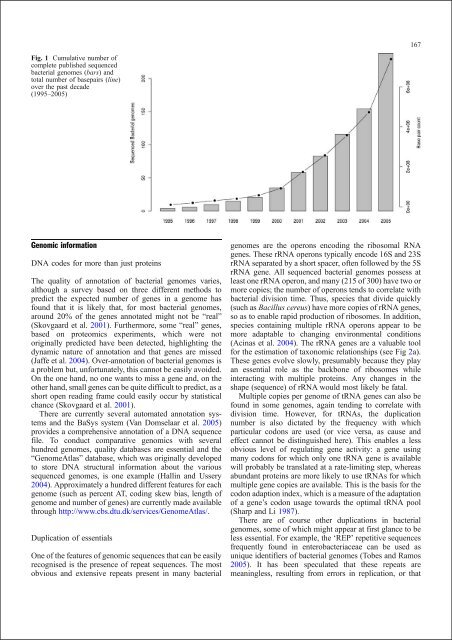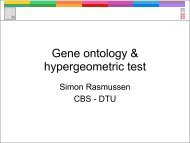Computational tools and Interoperability in Comparative ... - CBS
Computational tools and Interoperability in Comparative ... - CBS
Computational tools and Interoperability in Comparative ... - CBS
Create successful ePaper yourself
Turn your PDF publications into a flip-book with our unique Google optimized e-Paper software.
Fig. 1 Cumulative number of<br />
complete published sequenced<br />
bacterial genomes (bars) <strong>and</strong><br />
total number of basepairs (l<strong>in</strong>e)<br />
over the past decade<br />
(1995–2005)<br />
Genomic <strong>in</strong>formation<br />
DNA codes for more than just prote<strong>in</strong>s<br />
The quality of annotation of bacterial genomes varies,<br />
although a survey based on three different methods to<br />
predict the expected number of genes <strong>in</strong> a genome has<br />
found that it is likely that, for most bacterial genomes,<br />
around 20% of the genes annotated might not be “real”<br />
(Skovgaard et al. 2001). Furthermore, some “real” genes,<br />
based on proteomics experiments, which were not<br />
orig<strong>in</strong>ally predicted have been detected, highlight<strong>in</strong>g the<br />
dynamic nature of annotation <strong>and</strong> that genes are missed<br />
(Jaffe et al. 2004). Over-annotation of bacterial genomes is<br />
a problem but, unfortunately, this cannot be easily avoided.<br />
On the one h<strong>and</strong>, no one wants to miss a gene <strong>and</strong>, on the<br />
other h<strong>and</strong>, small genes can be quite difficult to predict, as a<br />
short open read<strong>in</strong>g frame could easily occur by statistical<br />
chance (Skovgaard et al. 2001).<br />
There are currently several automated annotation systems<br />
<strong>and</strong> the BaSys system (Van Domselaar et al. 2005)<br />
provides a comprehensive annotation of a DNA sequence<br />
file. To conduct comparative genomics with several<br />
hundred genomes, quality databases are essential <strong>and</strong> the<br />
“GenomeAtlas” database, which was orig<strong>in</strong>ally developed<br />
to store DNA structural <strong>in</strong>formation about the various<br />
sequenced genomes, is one example (Hall<strong>in</strong> <strong>and</strong> Ussery<br />
2004). Approximately a hundred different features for each<br />
genome (such as percent AT, cod<strong>in</strong>g skew bias, length of<br />
genome <strong>and</strong> number of genes) are currently made available<br />
through http://www.cbs.dtu.dk/services/GenomeAtlas/.<br />
Duplication of essentials<br />
One of the features of genomic sequences that can be easily<br />
recognised is the presence of repeat sequences. The most<br />
obvious <strong>and</strong> extensive repeats present <strong>in</strong> many bacterial<br />
167<br />
genomes are the operons encod<strong>in</strong>g the ribosomal RNA<br />
genes. These rRNA operons typically encode 16S <strong>and</strong> 23S<br />
rRNA separated by a short spacer, often followed by the 5S<br />
rRNA gene. All sequenced bacterial genomes possess at<br />
least one rRNA operon, <strong>and</strong> many (215 of 300) have two or<br />
more copies; the number of operons tends to correlate with<br />
bacterial division time. Thus, species that divide quickly<br />
(such as Bacillus cereus) have more copies of rRNA genes,<br />
so as to enable rapid production of ribosomes. In addition,<br />
species conta<strong>in</strong><strong>in</strong>g multiple rRNA operons appear to be<br />
more adaptable to chang<strong>in</strong>g environmental conditions<br />
(Ac<strong>in</strong>as et al. 2004). The rRNA genes are a valuable tool<br />
for the estimation of taxonomic relationships (see Fig 2a).<br />
These genes evolve slowly, presumably because they play<br />
an essential role as the backbone of ribosomes while<br />
<strong>in</strong>teract<strong>in</strong>g with multiple prote<strong>in</strong>s. Any changes <strong>in</strong> the<br />
shape (sequence) of rRNA would most likely be fatal.<br />
Multiple copies per genome of tRNA genes can also be<br />
found <strong>in</strong> some genomes, aga<strong>in</strong> tend<strong>in</strong>g to correlate with<br />
division time. However, for tRNAs, the duplication<br />
number is also dictated by the frequency with which<br />
particular codons are used (or vice versa, as cause <strong>and</strong><br />
effect cannot be dist<strong>in</strong>guished here). This enables a less<br />
obvious level of regulat<strong>in</strong>g gene activity: a gene us<strong>in</strong>g<br />
many codons for which only one tRNA gene is available<br />
will probably be translated at a rate-limit<strong>in</strong>g step, whereas<br />
abundant prote<strong>in</strong>s are more likely to use tRNAs for which<br />
multiple gene copies are available. This is the basis for the<br />
codon adaption <strong>in</strong>dex, which is a measure of the adaptation<br />
of a gene’s codon usage towards the optimal tRNA pool<br />
(Sharp <strong>and</strong> Li 1987).<br />
There are of course other duplications <strong>in</strong> bacterial<br />
genomes, some of which might appear at first glance to be<br />
less essential. For example, the ‘REP’ repetitive sequences<br />
frequently found <strong>in</strong> enterobacteriaceae can be used as<br />
unique identifiers of bacterial genomes (Tobes <strong>and</strong> Ramos<br />
2005). It has been speculated that these repeats are<br />
mean<strong>in</strong>gless, result<strong>in</strong>g from errors <strong>in</strong> replication, or that









